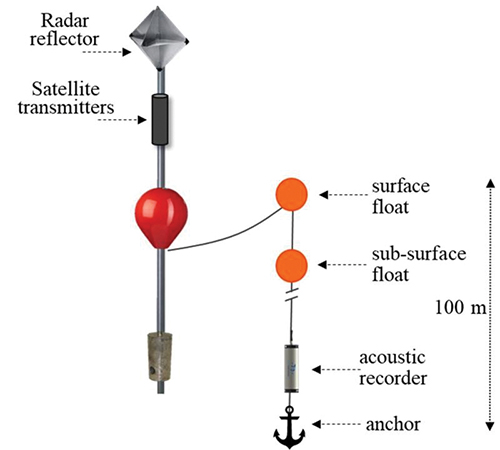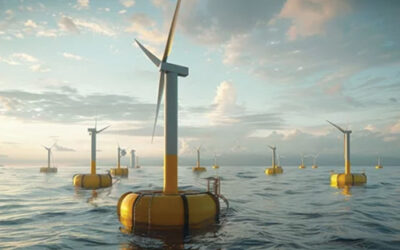As part of the effort to bring floating offshore wind turbines to the West Coast, a team of scientists has embarked on a study of the underwater sounds made by sea creatures in the wind area planned for off the Coast of San Simeon.
The study is being led by the Southwest Fisheries Science Center down in LaJolla, in cooperation with the Monterey Bay National Marine Sanctuary, which provided the research vessel Fulmar, and other agencies, as well.

Cory Hom-Weaver, a Cal Poly graduate with the Southwest Fisheries Science Center welcomed a reporter onboard the research vessel, Fulmar, as she was tied to Morro Bay’s South T-Pier, waiting out some offshore bad weather in the protected Harbor.
Their study, which is being conducted by a mostly female group of scientists with various specialties, is to listen in on the Pacific Ocean’s “soundscape,” recording what they hear at different depths and then trying to decipher what animals made what sounds or if it’s not biological in origin, where is the sound coming from?
Their goal is to identify and documents sounds to determine which species are found in the wind area (some 375-square miles, 20-30 miles offshore), how many are there, how often are they there, and when they do they swim through?
Hom-Weaver picked up one of the “drift buoys” from the Fulmar’s back deck. It’s like a half dozen they launched on their way down from Monterey.
It’s basically, two parts — an above water shaft with a radar reflector, strobe light, GPS and satellite communications equipment; and below the water there’s a 100-meter rope, floatation balls, anchor, sea anchor and two hydrophones — underwater microphones.
It’s a pretty simple set up that Hom-Weaver said they normally set out in two groups of four. The floats regulate depth and the sea anchor regulates drift. After some time in the water, the boat goes back and retrieves them, downloading the data for analysis.
What do they hear? Turns out, lots of things, some of which they don’t know what it is.

Hom-Weaver shows an example of a sampling of the soundscape, which shows on the computer screen like a big blue expanse, with small blips of color down around the bottom of the graph.
Like any other graph, one axis is depth and the other is sound measured in megahertz. Where a sound blip lands on the graph, is how they determine what species made the sound.
The point, Hom-Weaver said, is to see what the underwater soundscapes are. The data they gather will be sent to the Bureau of Ocean Energy Management (BOEM), the federal agency overseeing the wind farm project. What BOEM does with it is up to them, she said, but the goal is to inform BOEM about the marine environment to help them draft mitigation measures that the companies that bought wind leases will have to do.
This is separate from environmental studies the companies will be doing as part of the permitting process. The project is looking to install a total of 3 gigawatts of generating capacity; but the President’s goal is 30 GW installed off the U.S. Coast.
The three companies that bought the Morro Bay Wind Area leases are: Equinor Wind US, LLC; Central California Offshore Wind, LLC; and, Invenergy California Offshore, LLC. There’s also a lease area up off Humboldt County, where Hom-Weaver said they’ve already conducted their drift buoy study.
Also on the boat is a scientist with the National Marine Sanctuary, which has some stationary sound buoys set out north of here for the Monterey Sanctuary and off Estero Bay as part of a study being done to establish the proposed Chumash Heritage NMS.
Aspen Ellis, a U.C. Santa Cruz grad student studying seabirds was also on the boat this trip. She is trying to identify species of seabirds and sizes of flocks in the wind area. Ellis said she, “counts birds and predicts which birds can be impacted.”
On the trip down, she mostly saw a lot of shearwaters in the wind area, she said.
Ellis’ goal is also to determine “who’s using what region, and when.”
Hom-Weaver’s focus is the animals that those who oppose putting wind turbines in the ocean worry about — whales, baleen whales specifically, and dolphins.
These animals use sound to communicate, navigate and to find food. Whales tend to have low frequency sounds and dolphins are at higher frequency, with some sounds beyond what humans can hear, sort of like dog whistles.
But Hom-Weaver said their equipment is able to record it and translate the sound to visual data on the computer.
Have they heard sounds that they have no idea what it is? “About a hundred times a day,” she said. “A lot of fish species are under-studied. Some sounds seem manmade but they’re biological.”
The official name of the study is “Adrift in the California Current” Project, and it’s being funded by BOEM, which is an agency under the National Oceanic and Atmospheric Administration. The marine sanctuaries are also part of NOAA.
Hom-Weaver said their study will eventually be posted online on Zooniverse, which contains numerous “citizen scientist” projects. Their posts will have tutorial videos, too.
That’s when the public will get a chance to contribute. Hom-Weaver said they want to enlist citizens to help them identify some of the sounds they are recording.
“It’s just pattern recognition,” Hom-Weaver said. “It takes experience and time learning the sounds.” They started with perhaps the most famous oceanic singers — humpback whales — celebrated for their singing.
“We have terabytes of data,” she explained. “We need help classifying it.”
In the end, their work and the work of other scientists, will help make sure this risky move of putting in floating wind farms offshore in deep water — essentially inventing a whole new power industry — can be done in a way that protects the marine environment and the most majestic of creatures that live there.
“When they put in the wind farms,” Hom-Weaver said, “it will change the soundscape tremendously.”




